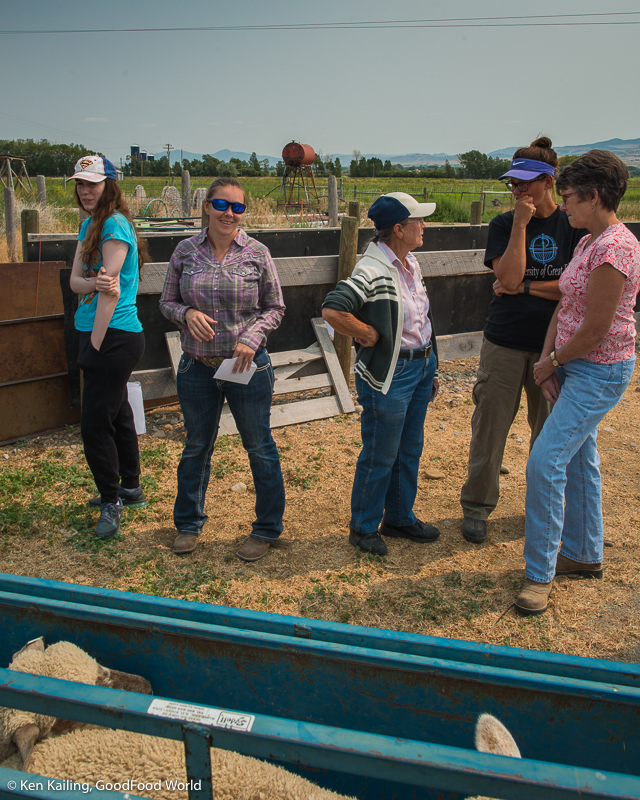Soil, air, rain, and sun supply all the essentials for the growing of a blade of grass. But they do not explain the grass.
Firman E. Bear, Earth: The Stuff of Life
(Take a virtual tour of the Scott’s ranch here. Click on any image to launch the slide show.)
Enclosed by surrounding mountain ranges, where black cattle and white sheep graze in sunshine filtered through a slight haze of wildfire smoke, a community comes together to concentrate on healthy animals, healthy soil, and healthy families.
 In small conference rooms, living rooms, and farmers’ fields, there are ranchers teaching ranchers new techniques to manage – and reduce – parasite infestation in small ruminants. Dave Scott, NCAT Agriculture Specialist and owner of Montana Highland Lamb, led friends and neighbors through diagnostic systems to identify infected sheep and methods to help control parasites.
In small conference rooms, living rooms, and farmers’ fields, there are ranchers teaching ranchers new techniques to manage – and reduce – parasite infestation in small ruminants. Dave Scott, NCAT Agriculture Specialist and owner of Montana Highland Lamb, led friends and neighbors through diagnostic systems to identify infected sheep and methods to help control parasites.
Sheep and goats are more susceptible to internal parasites than other livestock because of their grazing behavior and poor immunity. And as Dave says, “You can’t eliminate parasites, but you can control them in your animals and prevent the development of ‘super bugs’ that will sooner or later become resistance to any treatment man can invent.”
 Barber Pole Worm (Haemonchus Contortis), named because of its red and white coloring, is a common parasite in sheep and goats. The worm pierces the wall of the fourth and final stomach compartment in small ruminants and causes anemia by feeding on the animal’s blood.
Barber Pole Worm (Haemonchus Contortis), named because of its red and white coloring, is a common parasite in sheep and goats. The worm pierces the wall of the fourth and final stomach compartment in small ruminants and causes anemia by feeding on the animal’s blood.
While there are 10 times as many head of cattle as there are sheep (2.5 million cattle to 250,000 sheep), Montana is still one of the nation’s leading sheep producing states. Settled into chairs and couches in Dave and Jenny Scott’s comfortable living room, were a dozen or so neighboring sheep ranchers who incorporate organic and non-organic ranching methods for their flocks.
In his calm and matter-of-fact way, Dave offered proper – and prudent – methods of using medication to treat parasites and to prevent development of resistant parasites. Organic ranchers shared their experiences with alternatives such as garlic and diatomaceous earth.
Careful pasture management, including intensive rotational grazing, haying and tilling, or grazing horses, cattle, or other non-susceptible species, can “break” the parasite cycle. Everyone agreed that prevention and flock management is as important – or even more so – than treatment. Why medicate every animal in the flock when only a few are suffering from worm infection? The key question is this: How do you tell which animal needs treatment?
Out in the paddocks, armed with FAMACHA eye scoring cards, Dave lead the group of small ranchers as they learned one of the simplest way of identifying anemic animals. By rolling back the lower eyelid and exposing the inner mucus membrane, it’s possible to tell on a scale of 1 to 5 (1 is the healthiest and least affected by worms, 5 is the most anemic and most affected by worms) which animals need treatment and which do not. Matching the color of the lower membrane to the color on the score card, means ranchers can quickly tell the health of the animals.
Good animal husbandry depends on a holistic approach; incorporating and balancing all the elements of healthy animals, healthy soil, and healthy forage. How to get there? Develop resistant and resilient livestock, reduce exposure to parasites while acknowledging that strong, healthy sheep and goats can thrive with a moderate parasite load, practice good pasture management, and treat only those animals most affected by worms. Better for the animals, better for the soil, and better for the rancher!




